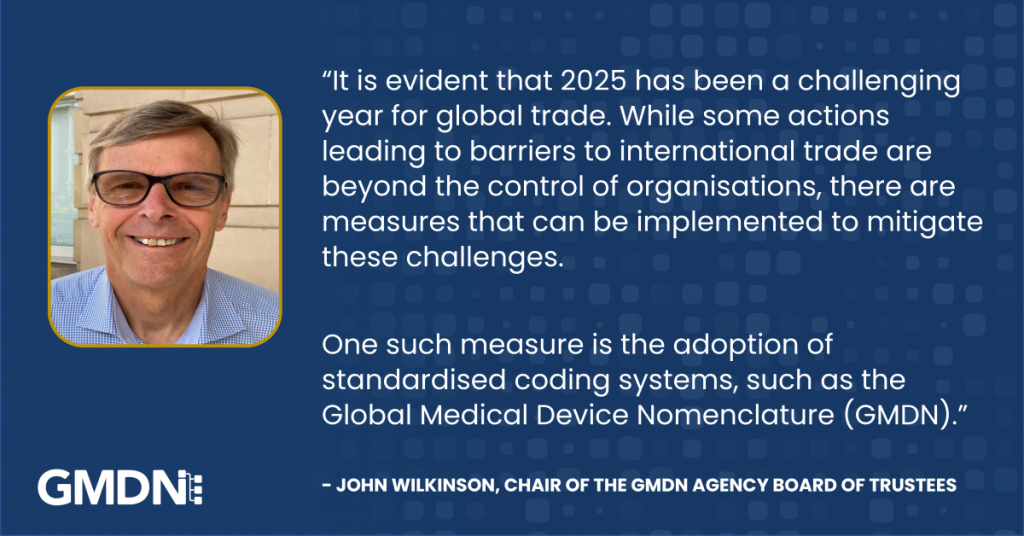Blog - The Role of GMDN in Reducing Barriers to the Global Medical Device Trade

4 June 2025
By John Wilkinson, Chair of the Board of Trustees, GMDN Agency
It is evident that 2025 has been a challenging year for global trade. While some actions leading to barriers to international trade are beyond the control of organisations, there are measures that can be implemented to mitigate these challenges. One such measure is the adoption of standardised coding systems, such as the Global Medical Device Nomenclature (GMDN).
By providing a universal language for medical device categorisation, that allows manufacturers, regulators, and healthcare providers to navigate the complexities of market access, the GMDN helps streamline regulatory processes, enhance supply chain accuracy, and improve patient safety.
This article explores the pivotal role of GMDN in reducing barriers to global trade and facilitating smoother market access for medical device manufacturers.
The Challenge of Global Trade
Medical devices are subject to stringent regulations that vary across different jurisdictions. Manufacturers aiming to enter international markets must comply with country-specific requirements, which often include distinct classification systems, documentation standards, and approval processes. This fragmentation can slow down market entry, increase costs, and create inefficiencies for businesses striving to expand their reach.
Without standardised terminology, regulators may face difficulties in grouping and comparing similar medical devices across different regions, leading to prolonged approval timelines and complications in trade negotiations. Healthcare providers and procurement professionals also encounter challenges when sourcing devices, as inconsistent classifications can result in misinterpretations that impact supply chains and patient care.
How GMDN Simplifies Global Trade
The GMDN system provides a standardised and globally recognised nomenclature that harmonises the classification of medical devices. Here’s how it helps remove obstacles in global market access:
Consistency Across Regulatory Bodies
One of GMDN’s primary advantages is its alignment with international regulatory frameworks. Agencies such as the U.S. Food and Drug Administration (FDA) and other national authorities’ reference GMDN Codes in their databases, ensuring that manufacturers can present their devices with a uniform classification. This consistency streamlines approval processes, making it easier for companies to meet the requirements of multiple markets without extensive reclassification efforts.
Improved Supply Chain Accuracy
Global trade relies on efficient supply chain management, particularly in the healthcare sector. GMDN Codes enhance accuracy by providing precise device descriptions, allowing manufacturers and distributors to accurately track and manage inventory. Healthcare providers benefit from simplified procurement procedures, ensuring they receive the correct devices without confusion.
Enhanced Patient Safety
Standardised coding plays a direct role in improving patient safety. By using GMDN Codes, regulatory agencies can monitor device performance and identify safety trends more effectively. If a specific device category demonstrates recurring issues, global health authorities can take swift action to issue recalls or safety advisories, preventing potential harm to patients.
Facilitating Trade Agreements
Countries and trade blocs negotiate agreements that determine how medical devices can be marketed across borders. The presence of a universally accepted nomenclature strengthens negotiations by removing classification discrepancies, making it easier for regulators to compare product categories and reach consensus. As a result, businesses experience fewer delays in meeting international market entry requirements. This aligns with the principles outlined in the WTO report on technical barriers to trade, which emphasises the importance of harmonised standards in facilitating global trade[1].
Simplifying Compliance for Manufacturers
For medical device manufacturers, compliance with international regulations is a complex and costly endeavour. GMDN Codes help simplify this process by providing an industry-standard language that regulators across the globe recognise. This enables companies to expand into new markets with greater confidence, reducing the need for multiple classification systems and redundant documentation.
Customs Inspections
Products can very easily get caught up in customs if it is not very clear what exactly they are. GMDN codes allow unambiguous identification that can be aligned to any border related processes and help facilitate rapid clearance and movement of products across international boundaries.
Supporting Digital Healthcare and AI Integration
The rise of digital healthcare and artificial intelligence (AI)-driven analytics requires structured data for optimal performance. GMDN Codes contribute to this evolution by enabling precise categorisation within electronic health records and AI-powered diagnostics. When medical devices are uniformly classified, automated systems can analyse trends, predict equipment needs, and support clinical decision-making more efficiently.
Looking Ahead: The Future of Standardised Coding
As the medical device industry continues to evolve, GMDN will play an increasingly vital role in shaping global trade. Efforts to further harmonise international standards will lead to smoother market entry processes, fewer regulatory bottlenecks, and enhanced collaboration between industry stakeholders. Innovations in AI-driven classification and blockchain-based supply chain tracking may further integrate standardised coding into digital ecosystems, enhancing efficiency and reliability across borders.
The ongoing refinement of GMDN ensures that manufacturers, regulators, and healthcare professionals’ benefit from a unified system that fosters trade, supports compliance, and prioritises patient safety. By reducing barriers through standardised classification, GMDN empowers the medical device industry to navigate the complexities of global markets with greater ease and confidence.
[1] World Trade Organization – Committee on Technical Barriers to Trade – THEMATIC SESSION ON REGULATORY COOPERATION BETWEEN MEMBERS ON MEDICAL DEVICE REGULATION https://docs.wto.org/dol2fe/Pages/SS/directdoc.aspx?filename=Q:/G/TBT/GEN405.pdf&Open=True
